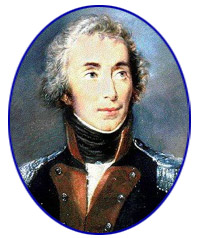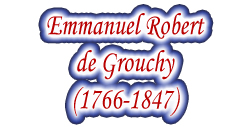

Click to see full text of the Chapter victor_ivanov@ukr.net
Argument of the Chapter
Marshal Emmanuel Robert de Grouchy
Early years. Study in artillery school. Service in Royal Guard. Support of Revolution. Grouchy as a brigade general. Retirement from the army for aristocratic origin. Return to service in National Guard as a volunteer. Participation in suppression of Royalist rebellion in Vendee. Victory over rebels at Cuiberon. General Hoche. Grouchy as a brigade general and Western Army Head of Staff. Preparation of landing to Ireland.
Grouchy as the division general and commander of occupation troops in Piedmont. Division commander in Italian army general Joubert. Italian campaign of 1799 under command of general Perignon. The battle at Novi. Bravery of Grouchy during the lost battle. Wound and captivity. Return to France. Participation in the battle at Hohenlinden.
The resons of non-including Grouchy to the list of marshals. Position of cavalry inspector which he was helding by beginning of Prussian campaign of 1806. Grouchy as a dragoon division commander in the structure of Murats Reserve Cavalry Corps. The battle at Jena. Crushing defeat of retreating Prussian troops at Weimar. Local victory at Zeddenick. Attack of Luebeck fortress. Polish Campaign of the years 1806-1807. Unlucky roundabout maneuver at Markow. First skirmishes with Russian Cossacks. Prelude to Preysisch-Eylau the battle of Grouchy with Bagration at Landsberg. Participation in famous cavalry attack of February 8. Grouchy got his 23-rd wound during this battle. Battle at Friedland. Crushing defeat of Russian right-flank group of general Gorchakow.
Grouchy the governor of Madrid. Bloody suppression of peoples distempers on May 2, 1808. Grouchy as a cavalry commander of Beauharnais Italian army. Austrian Campaign of 1809. Personal Grouchy in victory under Archduke John at Raab river. Help of general Montbrun. Wagram. Support of Davouts Corps attack. General-colonel of Guard mounted chasseurs.
Commander Reserve cavalry Corps in Russian campaign of 1812. The battle at Mount Valutina. The battle of Borodino. Support of Beauharnais Corps attack at Big Redoubt. Roundabout maneuver of Russian cavalry under command of Uvarow and Platow. Grouchy is wounded and compelled to leave the battlefield. Creation of «Holy Squadron» during retreat from Russia.
Grouchy didnt received marhals baton and left the army until beginning of campaign 1814. General operation plans of Napoleon. Big success at Brienne against Bluecher. Victory at Formantier. Successful counter maneuvers against Bluecher at Morchand and Vallejuan. Serious tactical mistake in the battle at Craon. Benevolence of Louis XVIII. Transition to the side of Napoleon, who has returned back. Grouchy as the general-governor of Lyons. Crushing defeat of Duke of Angulemes royalist troops. Marshals baton in turn of graft. Grouchy, the last Napoleons marshal.
Belgian campaign of 1815. Marshal Grouchy as the commander of four Reserve Cavalry Corpss. Forces of the opponents and operation plans before the resolute battle. Slowness of Grouchy in sending reserves during the battle of Quatr-Brais June 15. Fixed idea about necessity of defending the roads to Brussels. The battle at Ligny on June 16. Fatal tactical mistake of Napoleon. Unfinished defeat of the Prussians. Discrepant Napoleons order to keep an eye on Bluecher. Foolish maneuver on the right bank of the river Diel. Analysis of marshal Grouchys maneuvers. Complacency during absolute lack of information about the current situation. Refusal from general Gerards request to move and be united with the main forces. Fatal delay. Successful retreat to France through Namur. Resignation. Shame of the main culprit of the defeat at Waterloo. Emigration to the USA. Death.
Analysis of military leaders activities of marshal Grouchy. Was marshal Grouchy guilty in the defeat at Waterloo?
Maps of the Chapter Marshal Emmanuel Robert de Grouchy
1. The coast of Ireland.
2. Battle at Hohenlinden.
3. Situation at February 7, 1814.
4. Battle at La Rothiere.
5. Belgium, 1815.
6. The vicinities of Quatr-Brais.
7. The fragment of the battlefield ( vicinities of Ligny).
8. Situation at the beginning of a resolute collision.
9. The battle-field.
10. Battle at Wavre.
11. The British armys positions.
12. Battle at Waterloo.
Illustrations of the Chapter Marshal Emmanuel Robert de Grouchy.
1. The Arms of Grouchy.
2. Portrait of general Hoche.
3. Portrait of general Bellegarde.
4. Portrait of general Grouchy.
5. The Russian cavalrys uniforms:
Dragoon of the Kargopol Regiment 1803-1807;
Officer of the Kargopol Regiment 1803-1807;
Dragoon of the Kargopol Regiment 1808-1814;
Officer of the Kargopol Regiment 1808-1814.
6. The events of May 2 1808 at Madrid.
7. The medal for May 2 1808.
8. The Cross for May 2 1808.
9. Portrait of general Platow (painted by Dow).
10. Portrait of general Delzon.
11. Portrait of general Colencourt.
12. Portrait of Duke of Wurttemberg.
13. Portrait of Duke of Anguleme.
14. Portrait of Field-Marshal Bluecher.
15. Portrait of general Bulow.
16. Portrait of general Kleist.
17. Portrait of general Thielmann.
18. Portrait of general Pirch.
19. Portrait of general Gerard.
20. Portrait of general Ornano.
21. Marshal Grouchys grave.
The structure of military-historical monograph
«Military campaigns of Napoleons marshals»
Preface.
Introduction.
Chapter 1 marshal Jean Baptiste Jules Bernadotte, Prince of Ponte Corvo (1763-1844).
Chapter 2 marshal Louis Alexander Berthier, Prince of Neuchatel, Prince of Walange, Prince of Wagram (1753 1815).
Chapter 3 marshal Jean Baptiste Bessieres, Duke of Istria (1768-1813).
Chapter 4 marshal Guillaume-Marie-Anne Brune (1763-1815).
Chapter 5 marshal Victor Claude Victor-Perrin, Duke of Belluno (1764 1841).
Chapter 6 marshal Laurent Gouvion Saint-Cyr, marquess (1764-1830).
Chapter 7 ģąšųąė Emmanuel Robert de Grouchy, marquess (1766-1847).
Chapter 8 marshal Louis Nicolas Davout, Duke of Auerstaedt, Prince of Eckmuhl (1770-1823).
Chapter 9 marshal Jean Baptiste Jourdan, count (1762-1833).
Chapter 10 marshal Francois Etienne Christophe Kellermann, Duke de Valmy (1735-1820).
Chapter 11 marshal Jean Lannes, Duke of Montebello (1769-1809).
Chapter 12 marshal Francois Joseph Lefebvre, Duke of Danzig (1755-1820).
Chapter 13 marshal Jacques-Etienne-Joseph-Alexander Macdonald, Duke of Tarente (1765-1840).
Chapter 14 marshal Auguste Frederic Louis de Viesse Marmont, Duke of Ragusa (1774-1852).
Chapter 15 marshal Andre Massena, Duke of Rivoli, Prince of Essling (1758-1817).
Chapter 16 marshal Bon Adrien Jeannot Moncey, Duke of Conegliano (1754-1842).
Chapter 17 marshal Adolphe Edouard Casimir Joseph Mortier, Duke of Treviso (1768-1835).
Chapter 18 marshal Joachim Murat, King of Naples (1767-1815).
Chapter 19 marshal Michel Ney, Duke of Elchingen, Prince of Moskwa (1769-1815).
Chapter 20 marshal Pierre Francois Charles Augerau, Duke of Castiglione (1757-1816)
Chapter 21 marshal Dominique-Catherine Perignon, marquis de Grenade (1754-1818).
Chapter 22 marshal Joseph Antoine Ponyatovsky, prince of Poland (1763-1813).
Chapter 23 marshal Jean-Mathieu Philiber Serurier (1742-1819).
Chapter 24 marshal Nicolas Jean de Dieu Soult, Duke af Dalmatia (1769-1851).
Chapter 25 marshal Louis Gabriel Suchet, Duke of Albufera (1770-1826).
Chapter 26 marshal Nicolas-Charles Oudinot, Duke of Reggio (1767-1847).
Conclusions.
Literature.